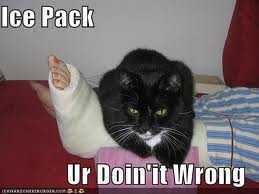Modalities: Ur Doin it Wrong?

So, when did you last really think about the modalities you applied to your patient?
As I sat through the last few lectures in a physical therapy "Interventions" class that includes training in various modalities, I am reminded that there is quite a lot of science behind the modalities we have in the clinic. What I am also reminded of is the fact that it is easy to get in a groove and do what is easy in the clinic versus process the sometimes painful clinical reasoning that is required for electromodalities. Today's lecture at the College of St. Scholastica, from where I graduated and now am honored to assist in an adjunct role, given brilliantly by faculty member Karen Swanson, consisted of terminology that frankly gets a bit mind-boggling unless you have some lecture material in front of you. There is direct current, alternating current, microcurrent, interfering current that happens before leaving the machine, interfering current that happens in the body, and specific ranges of current that produce specific effects.
Regarding electrical stimulation, have you ever made the following errors?
1. Applied premodulated bipolar interferential current and used 4 electrodes instead of 2?
2. Applied a TENS unit, using the 4 electrodes in an "x" fashion thinking the treatment area is between all 4 electrodes?
3. Kept the electrodes closer together to allow the current to be applied more deeply?
4. Applied Russian stimulation, telling the patient (as it was described by its inventor) that it is "painless?"
The title of this post, in the current mode of LOL cats and "Ur Doin' It Wrong" humor is not meant to point fingers, rather my goal is to stimulate some thought about why we are doing what we are doing in the clinic.A clinical approach I hear that astounds me is the complete dismissal of all modalities that require a plug-in. "There's no research..." is one of the more common excuses that I hear. When was that information last confirmed? Ultrasound in particular has received a bad rap in the clinic, however, the articles that were relied upon to conclude that ultrasound has no merit were later found to not be considered worthy research articles. Also of note is the updated information that unless you are treating a scar or trigger point in the muscle, applying ultrasound over a muscle belly is not recommended. Rather, the tissue heating effects of ultrasound are best applied over tendons and ligaments.
How do we stay current in the clinic when it comes to modalities? Attending a session at a national conference, or a continuing education course is a great place to start. Another option is to rely upon the students or new graduates who are hopefully making their way into your workplace. Ask them to give an inservice, or invite your local modalities representative in and request recent research. The next time that you apply a modality that has optional settings, ask yourself why you are applying the modality at those settings? You can also invest in an updated copy (5th Edition!) of Michlovitz's Modalities for Therapeutic Intervention (just updated this year.) In our profession, there are few situations that rely upon a cookbook approach, and we must rely upon clinical reasoning skills rather than habits. And if you are a new graduate, don't allow a more experienced therapist to enforce upon you his or her bad habits, and be sure to share all the updated, good bits you have learned in your extensive training!
By accepting you will be accessing a service provided by a third-party external to https://hermanwallace.com/



































